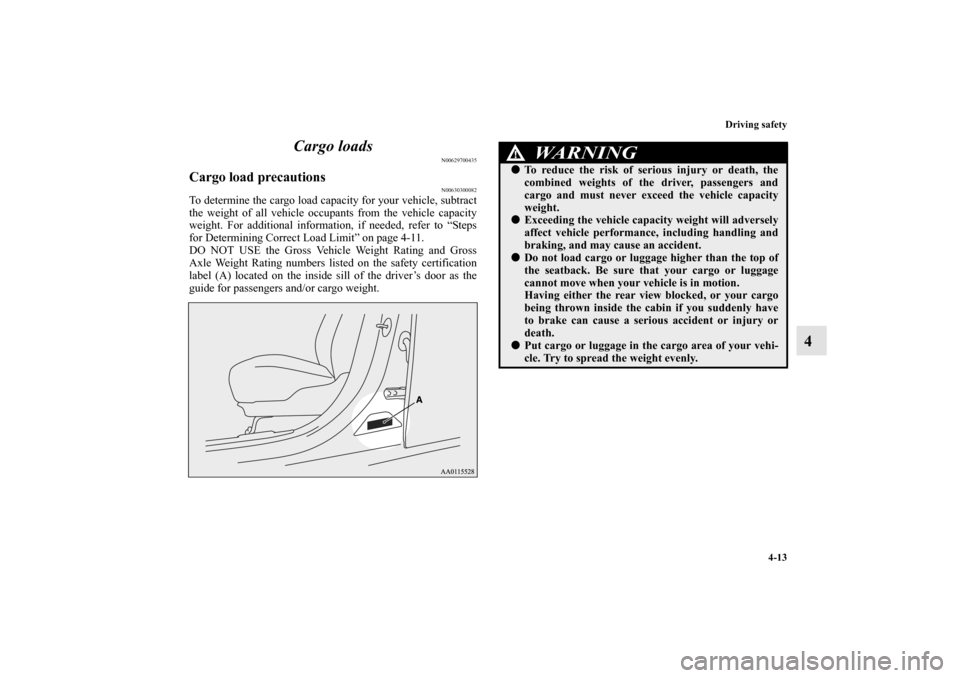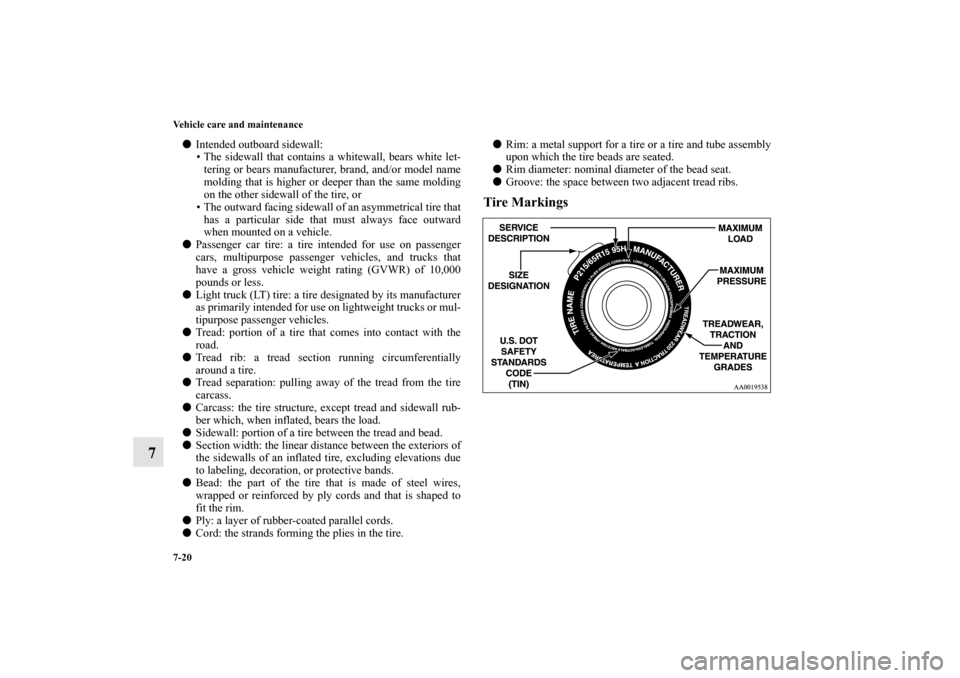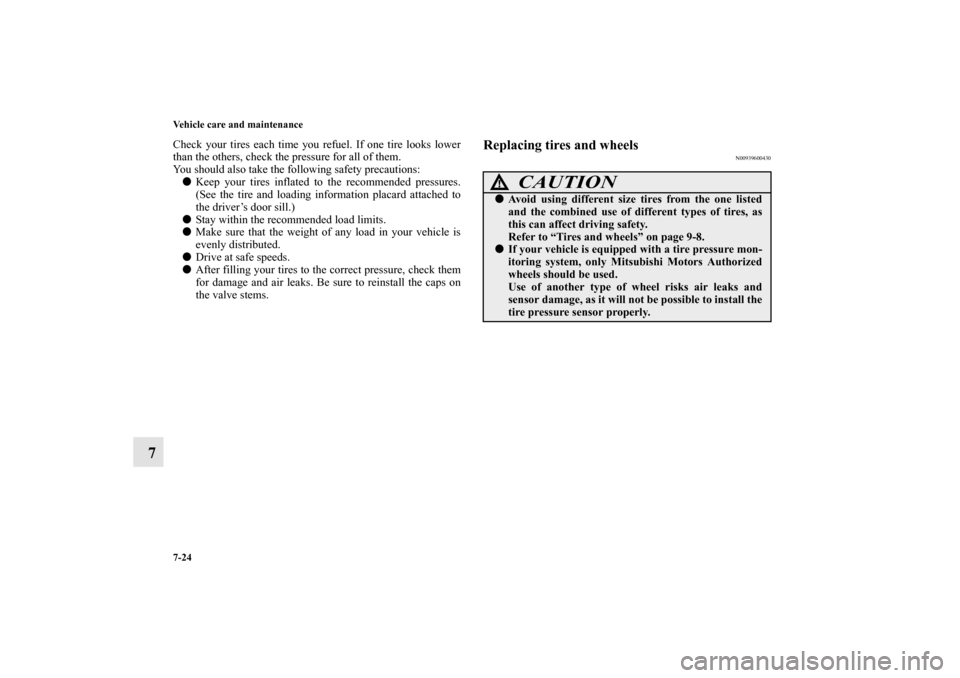Page 270 of 460
4-12 Driving safety
4
NOTE�The following table shows examples on how to calculate total cargo/load capacity of your vehicle with varying seating config-
urations and number and size of occupants. This table is for illustration purposes only and may not be accurate for the seating
and load capacity of your vehicle.
�For the following example the combined weight of occupants and cargo should never exceed 865 lbs (392 kg).
�Under a maximum loaded vehicle condition, gross axle weight ratings (GAWR’s) for the front and rear axles must not be
exceeded. For further information on GAWR’s, vehicle loading, see the “Specifications” section of this manual.
BK0162600US.book 12 ページ 2013年3月22日 金曜日 午後2時41分
Page 271 of 460

Driving safety
4-13
4 Cargo loads
N00629700435
Cargo load precautions
N00630300082
To determine the cargo load capacity for your vehicle, subtract
the weight of all vehicle occupants from the vehicle capacity
weight. For additional information, if needed, refer to “Steps
for Determining Correct Load Limit” on page 4-11.
DO NOT USE the Gross Vehicle Weight Rating and Gross
Axle Weight Rating numbers listed on the safety certification
label (A) located on the inside sill of the driver’s door as the
guide for passengers and/or cargo weight.
WA R N I N G
!�To reduce the risk of serious injury or death, the
combined weights of the driver, passengers and
cargo and must never exceed the vehicle capacity
weight.�Exceeding the vehicle capacity weight will adversely
affect vehicle performance, including handling and
braking, and may cause an accident.�Do not load cargo or luggage higher than the top of
the seatback. Be sure that your cargo or luggage
cannot move when your vehicle is in motion.
Having either the rear view blocked, or your cargo
being thrown inside the cabin if you suddenly have
to brake can cause a serious accident or injury or
death.�Put cargo or luggage in the cargo area of your vehi-
cle. Try to spread the weight evenly.
BK0162600US.book 13 ページ 2013年3月22日 金曜日 午後2時41分
Page 359 of 460

For emergencies
6-19
6
NOTE�The chocks shown in the illustration do not come with
your vehicle. It is recommended that you purchase chocks
or blocks and keep them in the vehicle for use if needed.
�If chocks or blocks are not available, use stones or any
other objects that are large enough to hold the wheel in
position.
6. Get the jack, bar and wheel nut wrench ready.
(Refer to “Jack and tools” on page 6-7.)
Spare tire information
N00849600344
Compact spare tireThe compact spare tire is stowed beneath the floor board of the
cargo area. It is designed to save space in the cargo area. Its
lighter weight makes it easier to use if a flat tire occurs.
WA R N I N G
!�Be sure to apply chocks or blocks to the correct tire
when jacking up the vehicle. If the vehicle moves
while jacked up, the jack could slip out of position,
leading to an accident.
WA R N I N G
!�Tires, including spare tire, degrade over time with
age even when they are not being used. It is recom-
mended that tires over 6 years generally be replaced
even if damage is not obvious.
CAUTION
!�While the compact spare tire is stowed, the inflation
pressure should be checked at least once a month to
assure that it remains at the recommended inflation
pressure. See the tire and loading information plac-
ard attached to the driver’s door sill. Refer to “Tire
and loading information placard” on page 9-4.�Driving with an improperly inflated tire can cause
an accident. If you have no choice but to drive with
an under-inflated tire, keep your speed down and
avoid sudden steering or braking, if possible. Inflate
the tire to the correct pressure as soon as possible.
Refer to “Tire inflation pressures” on page 7-23.
BK0162600US.book 19 ページ 2013年3月22日 金曜日 午後2時41分
Page 380 of 460
7-6 Vehicle care and maintenance
7
Support the engine hood with the hood prop. Insert the hood
prop securely in the opening under the hood marked with an
arrow.
To closeUnlatch the prop from the engine hood and put it back in its
retainer.
Slowly lower the engine hood about 8 inches (20 cm), then let
it drop from its own weight.
CAUTION
!�Always insert the support prop into the hole spe-
cially made for it. Propping the engine hood at any
other place could cause the prop to slip out and lead
to an accident.�The hood prop can fall out if the hood is lifted by a
strong wind.
CAUTION
!�Be careful not to trap your hands or fingers when
closing the engine hood.�Make sure the engine hood is firmly closed before
driving.
If you drive without the engine hood completely
closed, it could open up while driving.
BK0162600US.book 6 ページ 2013年3月22日 金曜日 午後2時41分
Page 394 of 460

7-20 Vehicle care and maintenance
7
�Intended outboard sidewall:
• The sidewall that contains a whitewall, bears white let-
tering or bears manufacturer, brand, and/or model name
molding that is higher or deeper than the same molding
on the other sidewall of the tire, or
• The outward facing sidewall of an asymmetrical tire that
has a particular side that must always face outward
when mounted on a vehicle.
�Passenger car tire: a tire intended for use on passenger
cars, multipurpose passenger vehicles, and trucks that
have a gross vehicle weight rating (GVWR) of 10,000
pounds or less.
�Light truck (LT) tire: a tire designated by its manufacturer
as primarily intended for use on lightweight trucks or mul-
tipurpose passenger vehicles.
�Tread: portion of a tire that comes into contact with the
road.
�Tread rib: a tread section running circumferentially
around a tire.
�Tread separation: pulling away of the tread from the tire
carcass.
�Carcass: the tire structure, except tread and sidewall rub-
ber which, when inflated, bears the load.
�Sidewall: portion of a tire between the tread and bead.
�Section width: the linear distance between the exteriors of
the sidewalls of an inflated tire, excluding elevations due
to labeling, decoration, or protective bands.
�Bead: the part of the tire that is made of steel wires,
wrapped or reinforced by ply cords and that is shaped to
fit the rim.
�Ply: a layer of rubber-coated parallel cords.
�Cord: the strands forming the plies in the tire.�Rim: a metal support for a tire or a tire and tube assembly
upon which the tire beads are seated.
�Rim diameter: nominal diameter of the bead seat.
�Groove: the space between two adjacent tread ribs.
Tire Markings
BK0162600US.book 20 ページ 2013年3月22日 金曜日 午後2時41分
Page 398 of 460

7-24 Vehicle care and maintenance
7
Check your tires each time you refuel. If one tire looks lower
than the others, check the pressure for all of them.
You should also take the following safety precautions:
�Keep your tires inflated to the recommended pressures.
(See the tire and loading information placard attached to
the driver’s door sill.)
�Stay within the recommended load limits.
�Make sure that the weight of any load in your vehicle is
evenly distributed.
�Drive at safe speeds.
�After filling your tires to the correct pressure, check them
for damage and air leaks. Be sure to reinstall the caps on
the valve stems.
Replacing tires and wheels
N00939600430
CAUTION
!�Avoid using different size tires from the one listed
and the combined use of different types of tires, as
this can affect driving safety.
Refer to “Tires and wheels” on page 9-8.�If your vehicle is equipped with a tire pressure mon-
itoring system, only Mitsubishi Motors Authorized
wheels should be used.
Use of another type of wheel risks air leaks and
sensor damage, as it will not be possible to install the
tire pressure sensor properly.
BK0162600US.book 24 ページ 2013年3月22日 金曜日 午後2時41分
Page 443 of 460
9
Specifications
Vehicle labeling . . . . . . . . . . . . . . . . . . . . . . . . . . .9- 2
Vehicle dimensions . . . . . . . . . . . . . . . . . . . . . . . .9- 5
Vehicle weights . . . . . . . . . . . . . . . . . . . . . . . . . . .9- 6
Engine specifications . . . . . . . . . . . . . . . . . . . . . . .9- 7
Battery . . . . . . . . . . . . . . . . . . . . . . . . . . . . . . . . . .9- 8
Tires and wheels. . . . . . . . . . . . . . . . . . . . . . . . . . .9- 8
Capacity . . . . . . . . . . . . . . . . . . . . . . . . . . . . . . . . .9- 9
BK0162600US.book 1 ページ 2013年3月22日 金曜日 午後2時41分
Page 448 of 460
9-6 Specifications
9Vehicle weights
N01147600917
GVWR: maximum total weight (load) limit specified for the vehicle
GAWR: maximum weight (load) limit specified for the front or rear axle
Seating capacity: the maximum number of occupants
Item
M/T
CVT
Gross vehicle weight rating 2,910 lb (1,320 kg) 3,020 lb (1,370 kg)Gross axle weight rating
Front 1,609 lb (730 kg)Rear 1,477 lb (670 kg)
Vehicle capacity weight 827 lb (375 kg)Seating capacity 5 personsBK0162600US.book 6 ページ 2013年3月22日 金曜日 午後2時41分